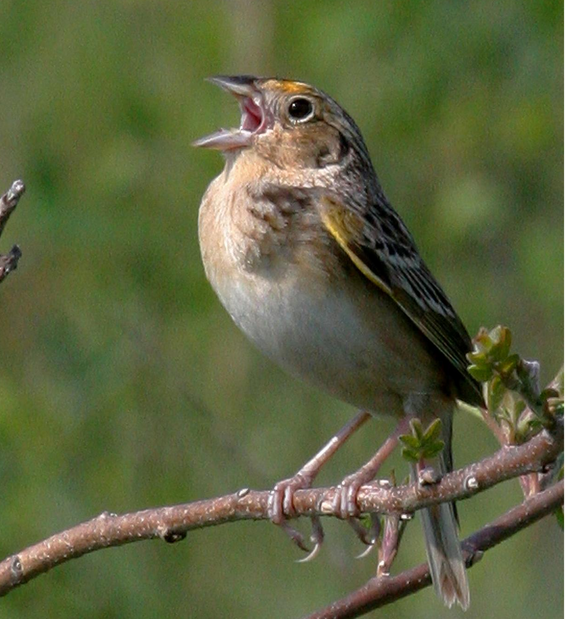Introduction

The state-listed grasshopper sparrow nests in grassland habitat.
A habitat is a group of plants and associated animal species that occur together. Some habitats like oak forests and woodlands or northern hardwood and conifer forests occupy large portions of the landscape and support many species including forest songbirds, hundreds of moth species, black bear, and moose. Other habitats such as acidic peatlands or coastal plain pondshores occupy relatively small patches but play a critical role in biodiversity conservation by supporting many rare plants and animals not found elsewhere.
Habitats and species overview
Massachusetts is home to an impressive diversity of plants and animals that rely on healthy habitats to survive and thrive. While some species are habitat generalists and use a variety of habitat types, others are highly specialized and only occur in a single habitat. To help guide conservation efforts, MassWildlife biologists have identified Species of Greatest Conservation Need (SGCN), including 453 rare plants and animals protected by the Massachusetts Endangered Species Act (MESA) and 167 additional species that are vulnerable and/or declining but do not require MESA listing at this time.
Habitats and Species of Greatest Conservation Need
Use the dashboard below to explore the relationship between habitats and species.
Habitats and natural communities
Massachusetts habitats have been grouped into 35 categories.
The habitats of Massachusetts can be further subdivided into distinct natural communities that are finer-scale groups of plants and animals that co-occur in distinct environmental settings. For example, the coastal beaches and dunes habitat includes the maritime beach strand community found between the intertidal zone and the dunes, and the maritime dune community. Some natural communities that are rare in the state or globally have been identified as conservation priorities. Each habitat description, accessed above, contains a list of associated natural communities.
Habitat protection and restoration
“A combination of approaches are needed to protect biodiversity—conserving groups of interconnected habitats in relatively large landscape blocks, targeted habitat protection and monitoring for rare species, and safeguarding vulnerable species before they decline.”
Conserving biodiversity in the Commonwealth means ensuring healthy and robust populations of all our native plants and animals. The best way to do this is by protecting groups of interconnected habitats in relatively large landscape blocks across the Commonwealth. Taking this “coarse filter” approach automatically protects most of the species that depend on these habitats—especially the more common ones.
In some cases, this approach may be insufficient to protect rare or uncommon habitats and their associated species, which may require protection and management in landscapes that are impacted by various stressors, such as degraded water quality. In cases like this, a “fine filter” approach may be needed—including protecting remaining habitat to the greatest extent possible and actively restoring, managing, and monitoring habitats and species populations to ensure persistence.
In today’s altered landscapes land protection is essential, but restoration and management are needed to conserve the rich diversity of plants, animals, and habitats in the Commonwealth. Many habitats need active restoration and managementto:
- remove invasive species;
- remove stressors and restore natural processes;
- mitigate changes to water quality or quantity, and/or
- improve climate resilience.
BioMap
By including both Core Habitat and Critical Natural Landscape—the coarse and fine filters—BioMap provides a holistic roadmap for biodiversity conservation in the Commonwealth. BioMap identifies large landscape blocks, forest, wetland, and aquatic cores that guide landscape scale conservation of interconnected habitats. BioMap also identifies core habitats for rare species and the best remaining forest, wetland, aquatic and vernal pool core habitats in each region of the state to help guide finer-filter conservation. Finally, BioMap’s Habitat Restoration Resource Center contains additional information about why habitat restoration is essential and practical guidance for landowners and others interested in implementing habitat restoration and management.